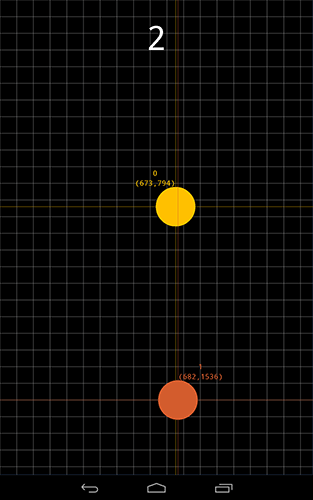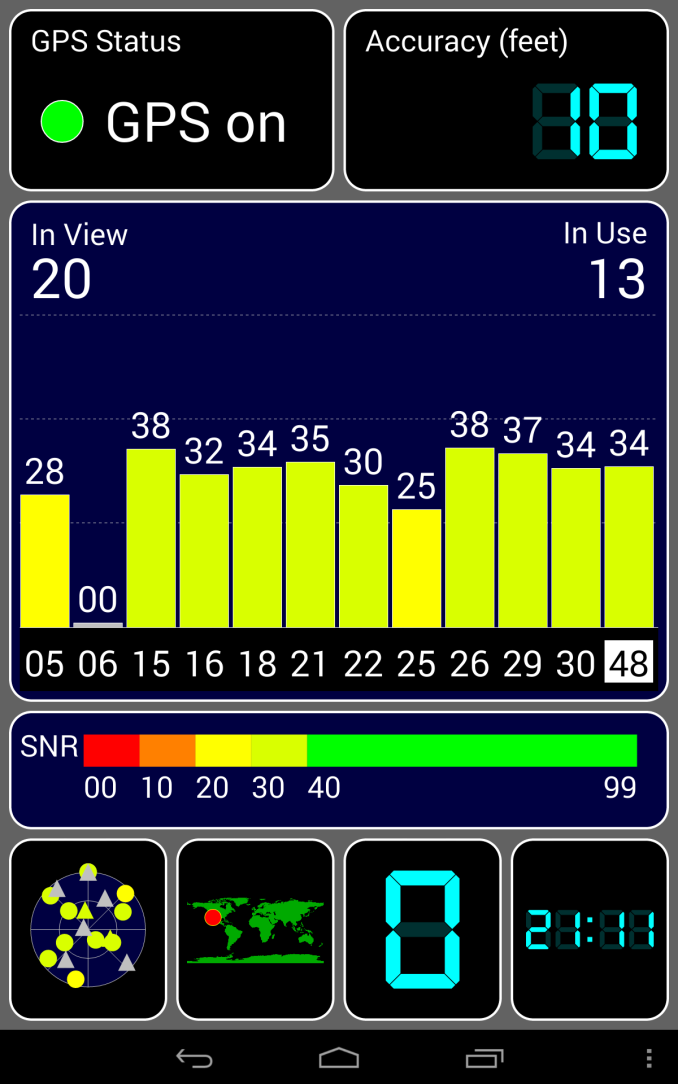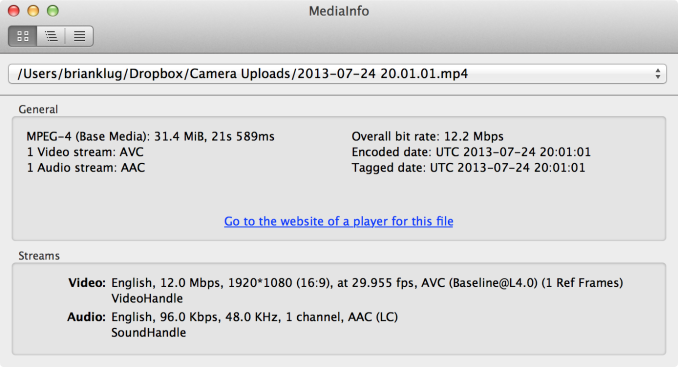The Nexus 7 (2013) Review
by Anand Lal Shimpi on August 22, 2013 6:00 PM ESTWiFi, GPS
I won't spend too much time on either of these points as Brian already did so in his initial review. WiFi duties are handled by Qualcomm's WCN3660 WiFi combo chip. The new Nexus 7 sees an update to include 5GHz 802.11n support, which is a very welcome addition. There's no 802.11ac, understandably for cost reasons. 802.11ac is probably the only thing missing from this otherwise awesome platform.

When it comes to GPS, there's good news and bad news. The good news is that Qualcomm's GNSS implementation remains the fastest we've tested as far as time to lock is concerned. The bad news is there seems to be an issue with the Nexus 7's impementation, likely in software, that results in the tablet randomly losing GPS lock. Update: It looks like this has been fixed!

Note that neither my Nexus 7 nor Brian's have exhibited the instability or consistent reboots that I've seen reports of. I had a single unexpected reboot during my GPS testing but that was it. Brian's sample has been running with over 22 days of constant uptime at this point. I also haven't seen any multitouch issues on my Nexus 7, although touch controllers are sometimes sourced from multiple vendors which could explain some of the issues others are seeing. Update: Looks like this one is fixed too!
Camera
The new Nexus 7 adds a 5MP rear facing camera, something its predecessor didn't have at all. While I rarely use my tablet for taking photos, I will admit the absence of a rear facing camera on the old Nexus 7 caught me off guard. Image quality out of the rear camera is decent. I threw together a gallery comparing the Nexus 7's rear camera to the iPad mini, MeMO Pad HD7 and Galaxy Tab 3 8.0:
In well lit situations and if you're sharing photos at lower resolutions, the Nexus 7's camera isn't bad at all. It's not the best thing in the world but in a pinch it's fine. I also threw in iPhone 5 samples as a reference in the gallery above.
Video on the Nexus 7 (2013) is 1080p30 at 12 Mbps, H.264 Baseline with 1 reference frame, and 96 kbps 48 KHz single channel AAC audio.


















202 Comments
View All Comments
darwinosx - Thursday, August 22, 2013 - link
I'll review it. It's a piece of junk with poor quality build, a washed out screen, and a really slow gpu. The iPad 4 blows the doors off it. Hows that?smartypnt4 - Thursday, August 22, 2013 - link
You're an incredibly negative individual, do you know that? Everyone knows the iPad 4 is better than the N10. That's never really been a debate. The N10 also costs $100 less, so there's that.I agree with your essential assessment, though. In essence, it had build quality issues, and a dreadful screen in comparison to the N7 and the iPad 3/4. Colors were washed out, it was incredibly dim, lacked contrast, etc. The really slow GPU thing I can't really attest to, although benchmarks indicate it's not *horribly* slow, especially for something that came out last year. Yes, it's slower than the iPad 4. Basically, anything released within ~6 months of an iPad historically can't match the GPU power. Comparing it to the Android space, it was relatively quick last year. Not so much now, though.
I do agree with you, though. Proof: when my N10 was stolen, I replaced it with an iPad 4.
Midwayman - Friday, August 23, 2013 - link
Anything from 2012 with a full HD screen or higher running Android was underspec'd anyways. They hadn't upped the hardware to deal with the demands of the higher res screens yet. 2013 is looking to be a different matter.smartypnt4 - Sunday, August 25, 2013 - link
After owning and using the N10 at launch last year, I can say that I never felt that the GPU held it back in the OS. The transitions were all very smooth throughout the OS. Some apps behaved weirdly, but that was because they rendered to a fixed size, which looks comical on a tablet with a pixel density that high. There were plenty of other things that were off about the N10, though. Supposedly ASUS got the nod for this year's Nexus 10, so I'm looking forward to their take on it.jl0329 - Wednesday, October 9, 2013 - link
Go home, time to change your diaper you little brat.Krysto - Thursday, August 22, 2013 - link
I agree they should move to 8" next year, or at least 7.7", and no more than a width of five inches, because then it becomes too wide (the iPad Mini is too wide for one-hand use).But yeah I'd prefer it was a bit bigger to justify getting one when you already have a big smartphone.
sherlockwing - Thursday, August 22, 2013 - link
Don't know about you, but I bought a N7 2013 when I already have a GS4(5") and the Media viewing expewrience on the Nexus 7 is substantially better. The N7's display(22.02 in^2) is twice as large as GS4's(10.68 in^2), and 85% more space when viewing 16:9 content( 19.8 vs 10.68). I find it perfectly justifiable to buy even if I have a GS4.Now if your defination for "big smartphone" is a Note then I see your point. It won't take too much effort to get a 7.5" screen on N7 if the bezel is reduced to Ipad Mini level. The screen/front area ratio of N7 is only 62%, Ipad mini's is 71.8%.
CSMR - Thursday, August 22, 2013 - link
"802.11ac is probably the only thing missing from this otherwise awesome platform"802.11ac will take years to start being used, and decades before it makes earlier wifi standards obsolete. In the life of a current device, there will be no occasions when 802.11ac will be available and providing internet but other wifi standards are not.
Lack of cellular connectivity on the other hand results in lack of internet access in most locations, and is a major omission.
solipsism - Thursday, August 22, 2013 - link
If you're defining it as not being used anywhere by anyone in favour of a new standard, then I guess I agree it will take decades. But by that notion there are people still using floppy disks.If you wish to be less draconian with your definition then your decades claim doesn't hold water. Including 802.11b in a device that supports 802.11g/n as a back up that is inexpensive for the component vendor to include doesn't mean it's being utilized extensively.
Also note is was only a decade between the 802.11b and n standards and 802.11n took off faster (for various reasons) than 802.11b so I can't see how it will be at least 2x longer before it gains a foothold, especially considering the focus society has for WiFi and excellent job the committee did in ratifying ac compared to n.
Finally, "there will be no occasions when 802.11ac will be available" and "802.11ac will take years to start being used" are just outright wrong. I use 802.11ac every single day. It's available! You can buy routers and devices that use this standard and they aren't priced at levels that make it unreasonable to obtain.
CSMR - Friday, August 23, 2013 - link
I was not saying it will take decades for people to start using 802.11ac. What will take decades is for them to switch off 802.11g and 802.11n. You may use 802.11ac now and good for you, but you can still get an internet connection with 802.11g/n. The main advertised advantage of 802.11ac is speed, but it will at least 10 years until typical internet connections saturate an 802.11g link let alone 802.11n.I am not against putting 802.11ac in devices as soon as it becomes a standard integrated part of modern chipsets, but the point is always-on internet is important, and if you do not have cellular connectivity then you will lack internet whenever you are outside your wifi network.